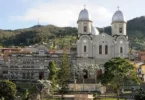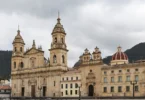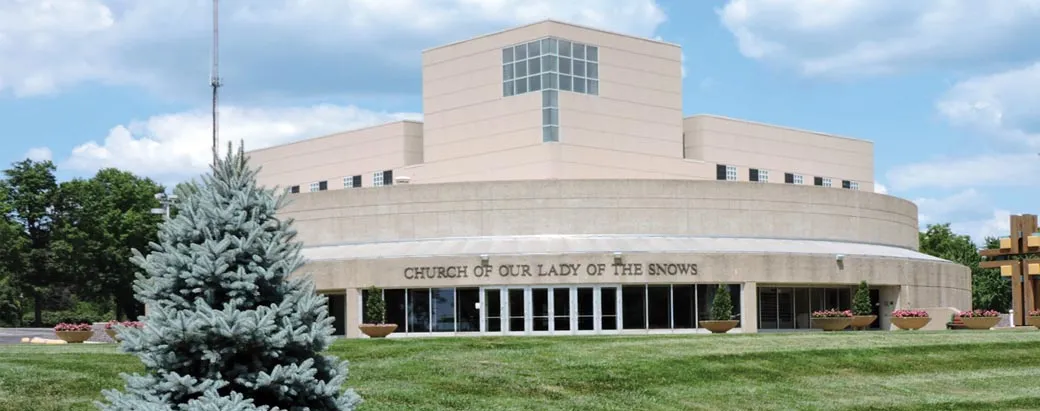
Introduction
The National Shrine of Our Lady of the Snows is a Catholic shrine to the Blessed Virgin Mary in Belleville, Illinois, nine miles southeast of St. Louis, Missouri. The Shrine’s director is the Reverend Father Salvador Gonzalez, OMI. The shrine is in the Roman Catholic Diocese of Belleville, but it is operated by the United States Province of the Missionary Oblates of Mary Immaculate. The Shrine name refers to the Basilica of Saint Mary Major in Rome, where legend says snow fell in the summertime. The National Shrine of Our Lady of the Snows, one of the largest outdoor shrines in North America.
Devotion to Mary under the title of Our Lady of the Snows is one of the oldest devotions to Mary. It has direct ties to the legend about a marvellous snowfall in Rome in 352 A.D. Mary had indicated in a dream to a wealthy, childless Roman couple that she wanted a church built in her honour and the site for this church would be covered with snow. On a hot, sultry morning on August 5, Esquiline Hill was covered with snow. All Rome proclaimed the summer snows a miracle, and a church to honour Mary was built on the hill in 358 A.D. Restored and refurbished many times, this church, now the magnificent Basilica of St. Mary Major, still stands today as the seat of devotion to Our Lady of the Snows in the Catholic Church.
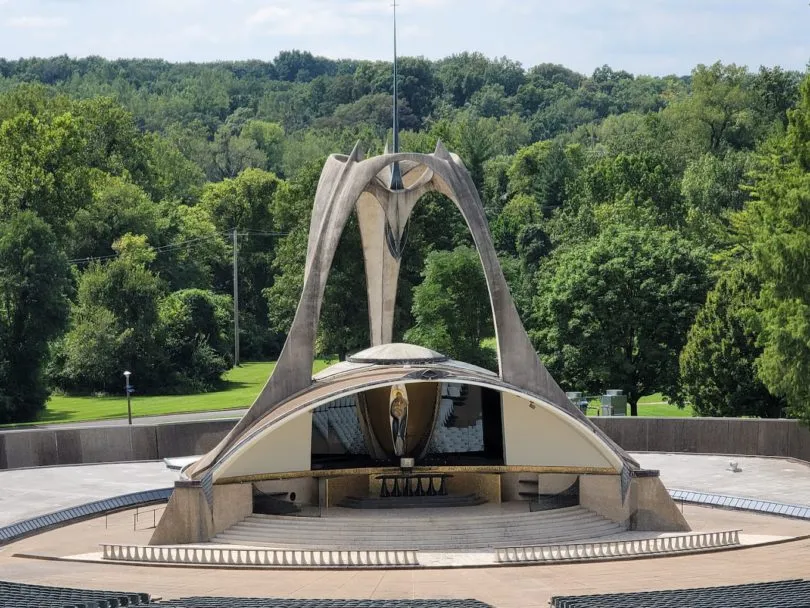
Oblates first arrivdepotth America in 1841. Referred to as the Cavalry of Christ, they often rode horseback as a means of travel while establishing missions in this untamed land. While their primary dedication will always be a spiritual calling, they reach out to those in need of physical, emotional, and or spiritual support through their sincere acts of charity.
Devotion to Our Lady of the Snows was first introduced to the Midwest in 1941 by missionary Father Paul Schulte, OMI. A small corner shrine was set up in a chapel at St. Henry’s Seminary in Belleville. In 1943 the Oblates began to hold a novena in honor of Our Lady of the Snows. The shrine was designed by sculptor William C. Severson and architect Richard Cummings.
The devotion to Our Lady of the Snows was first introduced to the Midwest in 1941 by the Missionary Oblates of Mary Immaculate. Fr. Paul Schulte, O.M.I., known as “the flying priest of the Arctic,” was a pilot who brought medical aid and supplies to remote Oblate missions, particularly north of the Arctic Circle. He developed a strong personal devotion to Our Lady of the Snows while working in the Oblate missions, and built a small chapel in her honor.
Fr. Paul Schulte, O.M.I., commissioned the famous artist, J. Watson Davis, to paint a picture of Our Lady of the Snows. Davis depicted an Oblate missionary and his airplane on a sick call to an Inuit (Eskimo) mission with Our Lady appearing surrounded by rays of the Northern Lights. Following his ministry in the Arctic, Fr. Schulte came to reside at St. Henry’s Seminary in Belleville, Illinois. The painting of Our Lady of the Snows was hung in the seminary chapel.
At that time, Fr. Schulte and Fr. Edwin Guild, O.M.I., began to develop the Missionary Association of Mary Immaculate and to foster devotion to the Blessed Mother under the title of Our Lady of the Snows. In April 1943, the perpetual novena to Our Lady of the Snows was begun.
The first Solemn Outdoor Novena was held in 1951, the final day being celebrated on August 5, the Feast of Our Lady of the Snows. The Novena became an annual event that soon attracted thousands each year.The painting of Our Lady of the Snows was given a place of prominence in the new chapel at St. Henry’s. Today, the J. Watson Davis painting is displayed in the Visitors Center Lobby at the National Shrine of Our Lady of the Snows.
As devotion to Our Lady of the Snows grew, the Oblates decided to look for a location for a shrine to be built in her honor. The search for a suitable site ended in February 1958 with the purchase of 80 acres of farmland on the bluffs overlooking the Mississippi River Valley. It seemed an ideal location for the proposed National Shrine of Our Lady of the Snows.
A newly formed Layman’s Association enabled laymen and women to take an active part in the development of the Shrine. The purchase of 20 additional acres became a reality through the generosity and dedication of the association. In the summer of 1958, work on the Shrine began.
It was important that the Shrine be an exceptional example of modern architecture, and that the devotional sites be strategically placed throughout the Shrine’s acreage. The landscape architect, Emmet Layton, enhanced the natural beauty of the site by directing the planting of trees, shrubs, and flowers at carefully selected spots.
Work on the shrine began in 1958 after Schulte had been developing the idea for years. By 1963, the shrine’s reflecting pool had already been completed. The pool is lined with bells that were originally cast in Germany from a demolished Chicago church.
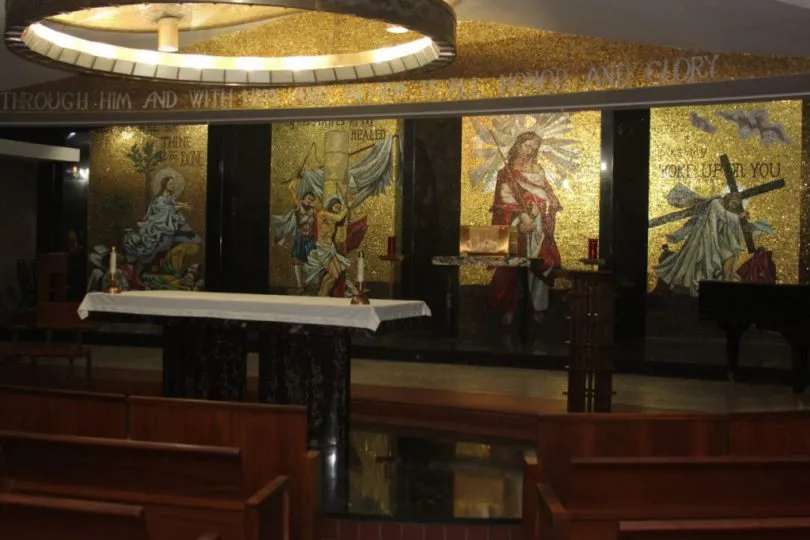
Hellmuth, Obata, & Kassabaum, Inc., the designers of the Church, gave careful attention to creating a worship space that would serve the needs of those who visit the Shrine. It was completed in 1990 and designed to meet the need for indoor worship space to accommodate the many visitors to the Shrine.
The impressive Main Shrine is situated at the base of a natural outdoor amphitheater. In addition to the permanent seating, the grassy slopes of the Amphitheatre can accommodate several thousand people. The Outdoor Altar’s graceful contour, enhanced by the talents of several artists, echoes the structural harmony and artistic integration found in Europe’s Renaissance cathedrals.
Christ the King Chapel, the Chapel of Santo Niño de Cebu, and the Rosary Courts are integrated into the Main Shrine area. A massive steel framework was built. Wet cement was sprayed over the entire structure to form a shell. Rising gracefully from the concrete shell is a 50′ concrete “M” which stands for Mary, the mother of Jesus. A 70′ spire rises from the apex of the symbolic “M” serving as a beacon guiding visitors to the magnificent setting. Three circles, representing the Holy Trinity, surmount a bronze cross. A bronze dove in downward flight is at the base of the spire, symbolizing the Holy Spirit.
The black marble altar in front of Our Lady of the Snows is the Main Altar for outdoor liturgies at the Shrine. Artist Rodney Winfield designed the large bronze crucifix, the tabernacle, and the pair of three-branched candelabras. The latticework of metal rings beside the chalice represents graces flowing to us from God. Additional rings and circles are reflected in the stonework on the first and second levels of the sanctuary, emphasizing Christ’s blessings to all who receive Him.
The black marble altar in front of Our Lady of the Snows is the Main Altar for outdoor liturgies at the Shrine. Artist Rodney Winfield designed the large bronze crucifix, the tabernacle, and the pair of three-branched candelabras. The latticework of metal rings beside the chalice represents graces flowing to us from God. Additional rings and circles are reflected in the stonework on the first and second levels of the sanctuary, emphasizing Christ’s blessings to all who receive Him.
In the gathering space is a stunning contemporary icon of Our Lady of the Snows, presenting her Divine Son for our contemplation and our imitation. Iconographer, Basil Lefchick, followed the centuries-old rule of fasting and praying while executing the stylized images of Mary and the Baby Jesus.
Our Lady of the Snows
The 16′ fiberglass statue of Our Lady of the Snows stands beneath the symbolic dove and before a tongue of fire. She is surrounded by a chalice, symbolizing her role as Christ’s Mother. Her gown is designed in the form of a Calla Lily, a symbol of purity. She holds the Christ Child up and forward, presenting her Son to the world.
Agony yard
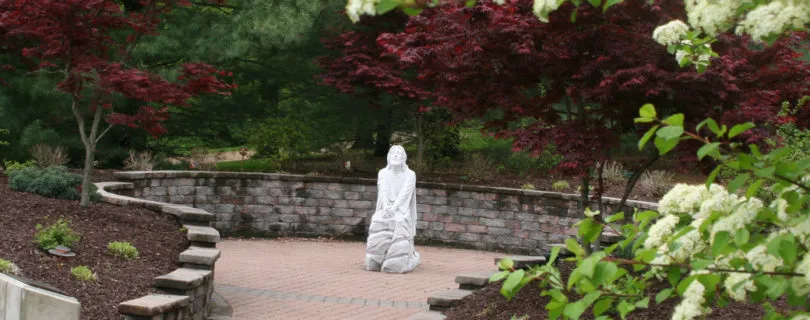
The Agony yard is a perfect place for visitors to pray and reflect in quiet solitude. A large Carrara marble statue of Jesus kneeling in prayer portrays Christ’s agony in the yard of Gethsemane on the night of His betrayal. Benches near the statue provide seating for those wishing to stay in the Agony yard for longer periods.
Annunciation yard
The Annunciation yard stands majestically on a hill overlooking the Main Shrine. The larger-than-life sculptures of the Blessed Virgin and the Angel Gabriel are mounted on a stone wall. It is located at the highest elevation of the Shrine, affording a panoramic view of much of the Shrine property.
Each hour is dramatically marked by the tolling of four large bells installed in a reflection pool. The bells, cast in Germany, were a gift from St. Bruno’s Parish, Chicago, Illinois. William Severson designed the copper Byzantine turrets that encase the bells. A fountain placed in the center of the pool enhances the refreshing setting.
Children’s Memorial Playground
A two-acre playground with a spiritual theme was added to the Shrine grounds in the summer of 2002. This recreational area is fun for children of all ages. It provides parents and grandparents a backdrop for some religious instruction. The seven days of creation are colorfully depicted in a rubberized walking surface that circles the playground. At the entrance to this wonderful play area is a life-size sculpture of a kneeling Jesus.
Lourdes Grotto
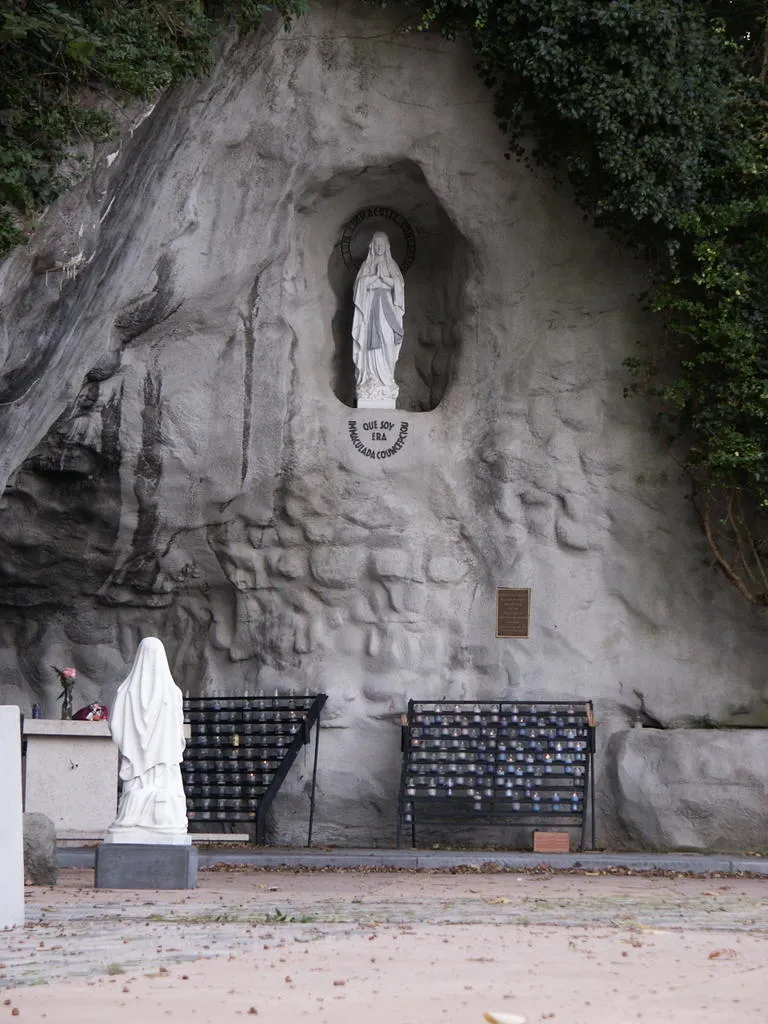
Located in a beautiful, wooded area, the Lourdes Grotto was among the first devotional sites completed at the Shrine. It is a replica of the famed Lourdes Grotto in France where Our Lady appeared in 1858 to a young, peasant girl named Bernadette Soubirous.
During the Grotto construction, finding a way to preserve the contours of the hillside while simulating the appearance of a rock cavern was a decided challenge for engineers. A local artisan proposed a way to duplicate the grotto at Lourdes. Dirt was piled up in such a way as to form a mold for the cavern.
Cement was poured over, around, and behind the dirt and mold to form a 3′ thick cement shell. The dirt was removed after the cement hardened and put on top of the structure. The result was nearly an exact reproduction scaled to two-thirds the size of the original Lourdes Grotto in France.
In 1961, the Annual Solemn Novena was the first held at the Shrine’s present location — was held at the Lourdes Grotto.
Today, the Lourdes Grotto is beautifully landscaped with flower gardens, trees, and shrubs and has been a favorite devotional site for pilgrims visiting the Shrine. A secluded altar is set within the Grotto for occasional Masses, especially during May and October, and for devotional services.
Mother’s Prayer Walk
The Mother’s Prayer Walk is a tribute to mothers everywhere. It was begun by Fr. Edwin J. Guild, O.M.I., founder of the Shrine, and is located next to the Annunciation yard. A Mother’s Memorial Wall flanks the curved walkway with bronze plaques honoring individual mothers. Seasonal flower gardens surround the memorial walkway throughout the year, especially in the summer months when the “Our Lady of the Snows” roses are in bloom. This beautiful location invites visitors to pause, meditate, and pray.
Our Lady of Guadalupe Hill
Our Lady of Guadalupe Hill, located behind the Annunciation yard, depicts the appearance of the Blessed Mother to Juan Diego, a recent convert to Christianity, at Tepeyac Hill in Mexico in 1531. This site, dedicated in 2005, honors Mary under the title of Our Lady of Guadalupe.
Resurrection yard
The Resurrection yard is located directly across the road from the last depot of the Way of the Cross. Some have called it the 15th Station of the Cross-Christ’s glorious Resurrection on Easter Sunday.
A concrete pathway leads the visitor up to and around the Resurrection Cave which resembles a giant stone. The cave is hollowed out on one side, revealing a cut geode, with a tomb-like vacant slab representing the Risen Christ.
A continuously burning flame reminds us of the everlasting life that Christ has promised us. Circling the Resurrection Cave are geode-shaped rocks that depict the appearances of Christ to the Apostles and others after His Resurrection.
Way of the Cross
For centuries, pilgrims have traveled to the Holy Land to retrace Christ’s steps during the events leading up to His death. Following the narrow streets of Jerusalem, the pilgrims pause to reflect and pray along the way.
The Shrine’s Way of the Cross enables persons to participate in this devotional tradition amidst a grove of evergreens and pines. Visitors follow the fourteen Stations of the Cross along a half-mile roadway. Each depot depicts a poignant grouping of exquisitely detailed, full-color statues of Christ, Mary, and the others who journeyed with Christ on His way to Calvary. Each depot is surrounded by natural beauty throughout the seasons.
Annual Feast Day
Feast day: August 5
The annual feast day of the National Shrine of Our Lady of the Snows Illinois is celebrated on 5th August each year.
Mass Timing
WEEKDAY MASSES
- Monday : Friday 07:30 am & 11:30 am
WEEKEND MASSES
- Saturday Masses : 09:00 am, 04:00 pm (Vigil Mass)
- Sunday Masses : 09:30 am, 11:30 am & 02:00 pm (Spanish/Español)
Contact Info
442 S Demazenod Dr,
Belleville, IL 62223,
United States
Phone No.
Accomodations
How to reach the Sanctuary
Airways
The nearest airport to the National Shrine of Our Lady of the Snows is which is 20 miles away from the shrine.
Railways
The nearest railway station to the National Shrine of Our Lady of the Snows is Fairview Heights IL, USA which is 8.3 miles away from the shrine.

